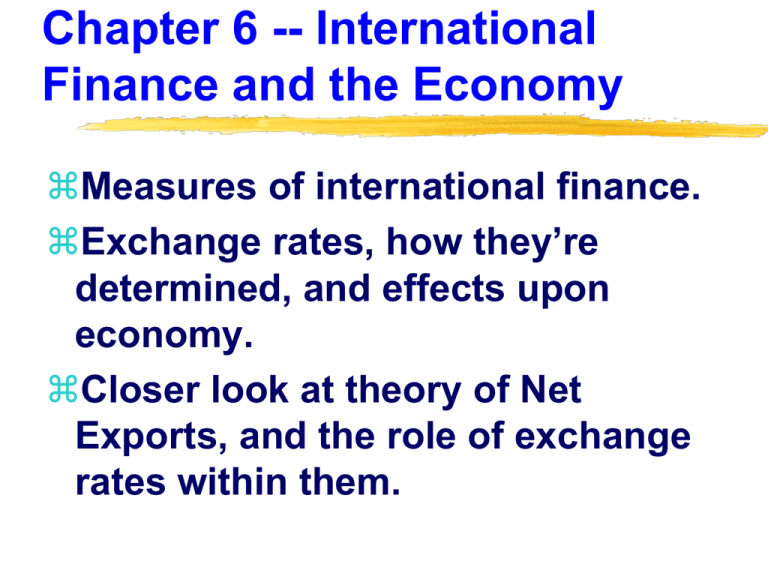Chapter 6 -- International Finance and the Economy
advertisement

Chapter 6 -- International
Finance and the Economy
Measures of international finance.
Exchange rates, how they’re
determined, and effects upon
economy.
Closer look at theory of Net
Exports, and the role of exchange
rates within them.
Measures of
International Finance
Record of transactions between
American residents and residents
of other countries over a flow
interval.
Current Account
Capital Account
Balance of Payments
The Current Account
Current Account =
{Exports + Foreign Transfers
to US + Income earned from
American holdings of investments
abroad}
-- {Imports + US Transfers to
Foreigners + Income earned from
foreign investments in US}
The Current Account:
Interpretation
Items in the first set of { } -- current
account inflows, ways that dollars
enter into the US from international
transactions in the current account.
Items in the second set of { } -- current
account outflows, ways that dollars
leave the US from international
transactions in the current account.
The Current Account:
Characteristics
Comprehensive measure of the
Balance of Trade (NX is a close
approximation).
The Capital Account
Capital Account =
{Net Foreign Purchases of
US Assets by foreign residents}
- {Net US Purchases of
Foreign Assets by US residents}
Capital Account =
{Capital Account Inflows}
- {Capital Account Outflows}
Can be interpreted as “net private
borrowing” from the foreign sector.
The Balance of Payments (BOP)
Balance of Payments outcome
= Current Account + Capital Account
Represents “what’s left over” after all
international transactions between residents
of the US (other than government) and
residents of other countries (other than
government) during a flow period.
Positive sign: Surplus, Negative Sign: Deficit
Balance of Payments deficits – financed by
government borrowing from foreign sector.
The Recent US Record -International Transactions
Current Account < 0
Capital Account > 0, but less than
|Current Account|
Balance of Payments < 0
Negative Balance of Payments –
financed by US borrowing from
foreign sector.
Balance of Payments and
Government Borrowing
Resulting equation:
BOP + (Net Government Borrowing
from Foreign Sector) = 0
(Current Account + Capital Account)
+ (Net Government Borrowing
from Foreign Sector) = 0
(Current Account)
+ (Total Net Borrowing from
Foreign Sector) = 0
The Balance of Payments
and the “Magic Equation”
“Magic Equation”: S + (T – G) + (-NX) = I.
Balance of Payments equation:
Current Account + (Total Net Borrowing
from Foreign Sector) = 0.
Also recall that
NX (Current Account).
Substitute the two expressions into Macro
Identity for (-NX)
S + (T – G) + (Total Net Borrowing from
Foreign Sector) = I.
Exchange Rates
(Nominal) Exchange Rate (e’) -- the
amount of foreign currency
needed to be exchanged for one
(US) dollar.
Also known as the “value of the
dollar”.
Conversion Ratio, in units of
(foreign currency)/(US dollar)
Types of Exchange Rates
Bilateral Exchange Rates -exchange rates between the US
and an individual country.
Multilateral (Trade Weighted)
Exchange Rate -- weighted
average of bilateral exchange rates
expressed as an index (macro
measure of exchange rate).
Exchange Rate Changes
e’ price of American goods and
services to foreigners
price of foreign goods and
services to Americans
e’ price of American goods and
services to foreigners
price of foreign goods and
services to Americans
The Real Exchange Rate (e)
e = (P)(e’)
(Pf)
P = US Price Level
Pf = Foreign Price Level
Key cause of net exports.
The Real Exchange Rate:
An Interpretation
e = (P)(e’)
(Pf)
Units of e:
= ($/Quantity)(Foreign Currency/$)
(Foreign Currency/Quantity)
= (Foreign Currency/Quantity)
(Foreign Currency/Quantity)
The Real Exchange Rate
and Price Comparison
e = (P)(e’)
(Pf)
It consists of the ratio of the price
level of American goods and
services -- expressed in units of
foreign currency -- to the price
level of (corresponding) foreign
goods and services.
The Real Exchange Rate
and Net Exports
e (P, Pf, or e’) substitution away
from the relatively more expensive US
goods and services (US) Exports,
(US) Imports NX
e (P, Pf , or e’) substitution into
the relatively cheaper US goods and
services Exports, Imports NX
Exchange Rate Regimes
Fixed (Pegged) Exchange Rates -e’ fixed, unless changed by
economic policy.
Floating Exchange Rates -- e’
determined by natural forces in the
foreign exchange market.
Managed Float -- floating e’ with
occasional Treasury/Federal
Reserve intervention.
The Foreign Exchange
Market -- Determination of e’
The Foreign Exchange Market -the demand and supply for dollars
for use in international
transactions.
Concepts to Understand
Foreign Exchange Behavior
Items (goods, services, financial
assets) are priced in a country’s
home currency.
If one wishes to buy from another
country, he/she must convert from
their own currency to the currency
of the country selling the item.
More Concepts:
Foreign Exchange
The nominal exchange rate (e’)
specifies the ratio of conversion.
One exchange rate (e’) is the
conversion ratio for all foreign
transactions (goods, services,
financial assets) – Law of One
Exchange Rate.
The Demand for Dollars
The Demand for Dollars -foreigners demand for US dollars,
to buy American goods, services,
or financial assets.
Inversely related to the nominal
exchange rate, with other causes
(shift variables) as well.
The Supply of Dollars
The Supply of Dollars -Americans supplying dollars to the
foreign exchange market, in order
to buy foreign goods, services, or
financial assets.
Positively related to the nominal
exchange rate, with other causes
(shift variables) as well.
Foreign Exchange
Market Equilibrium
Equilibrium exchange rate
(foreign
currency)/(US$)
-- “price of dollars.”
At equilibrium:
Current Account
+ Capital Account = 0
At equilibrium, the
Balance of Payments = 0.
Example 1 -- Increase in US
Interest Rates (i)
Increase in i leads to substitution away
from foreign financial assets to US
financial assets.
Foreigners substitute Demand for
Dollars Increases (curve shifts
rightward).
Americans Substitute Supply of
Dollars (Abroad) Decreases (curve
shifts leftward).
As a result, the equilibrium exchange
rate (e’*) Increases.
Example 2 -- Increase in
Foreign Interest Rates (if)
Increase in if leads to substitution away
from US financial assets to foreign
financial assets.
Foreigners substitute Demand for
Dollars Decreases (curve shifts
leftward).
Americans Substitute Supply of
Dollars (Abroad) Increases (curve
shifts rightward).
As a result, the equilibrium exchange
rate (e’*) Decreases.
Speculation -- Expectations
of Exchange Rate Changes
Example 3 -- consider the exchange
rate in units of foreign currency
(abbreviation -- fcu) per dollar.
e’ = (5 fcu)/($1), and you expect
(correctly) that it will decrease in the
future to (4 fcu)/($1).
Response -- sell dollars now, buy them
back when “cheaper.”
Capital Gains in the
Foreign Exchange Market
Continue example, start with $100.
Step #1 -- buy foreign currency at
the current exchange rate.
(100$)[(5 fcu)/($1)] = 500 fcu.
Step #2 -- convert back to dollars
when e’ decreases in the future.
(500 fcu)[($1)/(4 fcu)] = $125.
Capital gain of $25.
Floating Exchange Rates
Advantages
-- At market equilibrium, Balance of
Payments = 0, i.e. current account +
capital account = 0.
-- Federal Reserve does not need to
participate in foreign exchange market,
it can use the money supply to focus
solely on domestic policy.
Floating Exchange Rates
(Continued)
Disadvantages
-- Fluctuating exchange rate is
disruptive to International Trade
(exchange rate risk).
-- Exchange rates can fluctuate a
great deal, especially due to
speculation (speculative bubbles).
Fixed Exchange Rates
Advantages
-- exchange rate is constant,
stability in International Trade
(exchange rate risk = 0).
Fixed Exchange Rates
(Continued)
Disadvantages
-- Federal Reserve must intervene constantly
in the foreign exchange market to keep BOP
= 0 loses control of money supply.
-- Or country faces distorted Balance of
Payments position (negative or positive)
-- Fed might be forced into contractionary
monetary policy to raise i* and increase e’*
to the fixed rate.
Exchange Rate Regimes -Overall
Ideal system: floating exchange
rates which do not exhibit much
movement.
Actual system (US):
Managed Float -- floating exchange
rates with occasional Federal
Reserve intervention.
Exchange Rates and
the Macro Models
Review concepts:
-- Real exchange rate (e),
e = (P)(e’)/(Pf).
-- Real exchange rate is inversely
related to net exports,
i.e. e NX.
Causes of Net Exports -Fixed and Floating e’
Foreign Output or Income (Yf)
US Output or Income (Y)
Barriers to Trade
Causes of Net Exports,
Continued
Real Exchange Rate (e)
-- US Price Level (P),
P e NX
-- Foreign Price Level,
Pf e NX
-- Nominal Exchange Rate (e’)
e’ e NX
Further Decomposition -Causes of Net Exports
Real Exchange Rate (e)
...
-- Nominal Exchange Rate (e’)
(a) US interest rate (i)
i e’* e NX
(b) Foreign interest rate (if)
if e’* e NX
(c) Expectations of Future e’
Exchange Rates
and the IS-LM Model
Note -- causes (a), (b), and (c)
apply only to floating exchange
rates.
Fixed Exchange Rates and the
IS-LM Model -- e’ inflexible, cause
of autonomous Net Exports, shifts
IS curve.
Floating Exchange Rates
and the IS-LM Model
Since the nominal interest rate is a
cause of the nominal exchange
rate and Net Exports, this behavior
affects the slope of the IS curve.
Under floating exchange rates:
i* C, I, NX.
Additional response to interest
rate change greater elasticity
flatter IS curve.
Floating Exchange Rates
and Policy Effectiveness
Flatter IS curve under floating
exchange rates makes fiscal policy
less effective and monetary policy
more effective.
Recent Developments –
Exchange Rates
1971-73: US Transitions From System of
Fixed Exchange Rates to Floating Exchange
Rates Against Major Industrialized
Economies.
2006-: US pressuring China to convert from
Fixed Exchange Rate Regime to purely
Floating Exchange Rate (How Much Will
Yuan/$ Exchange Rate Decrease as a
Result?).
Recent Developments -International Trade
Movement toward reducing or
removing trade barriers
-- General Agreement on Tariffs
and Trade (GATT)
-- Replaced by World Trade
Organization (WTO)
Free Trade Agreements
Involving the US
-- North American Free Trade
Agreement (NAFTA), 1994.
-- Central American Free Trade
Agreement (CAFTA), 2005.
-- Free Trade Agreement of the
Americas (FTAA), Proposed.
More Developments
Creation of the European Union -economic bonding of major
European countries.
-- removing barriers to trade
among member nations
-- common currency (Euro)
-- one central bank for the
community
Challenges to the European Union
Uniform currency equivalent to fixed
exchange rate regime among member
nations.
To avoid large scale foreign borrowing
associated with fixed exchange rates and
BOP < 0, need for coordinated economic
policies among members.
Will nations with large budget deficits and
very sluggish economies (e.g. Greece)
accede to Germany’s fiscal-discipline based
economy?








